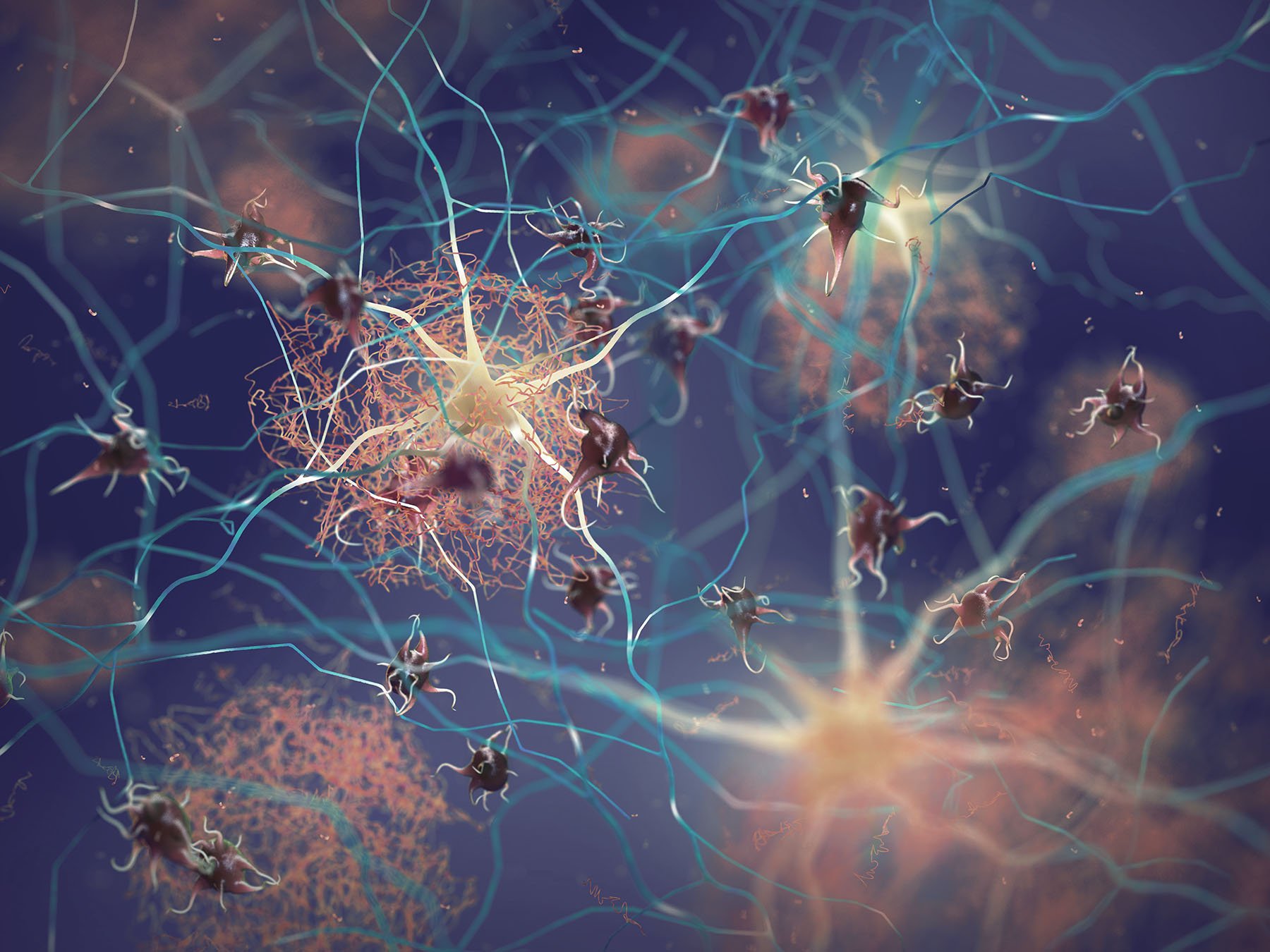The Study
Where: University of Colorado Anschutz Medical Campus
When: Published March 2023 in The American Journal of Clinical Nutrition
The Takeaway
This study investigated a potential role of an innate foraging instinct of our earliest ancestors in the development of Alzheimer’s disease in modern times. The researchers suggest that during periods of food scarcity for early humans, the brain produced fructose (a type of sugar). This fructose production inhibited parts of the brain—including areas responsible for memory—so that a human or animal could focus intently on the task of foraging.
For early humans, the researchers hypothesize, fructose’s role in memory loss was both life-saving and reversible. However, the researchers suggest that in modern times—in which humans often have abundant access to foods, including those with significantly higher doses of fructose, thanks to sweeteners like high fructose corn syrup—this survival mechanism can remain chronically activated. In turn, the overabundance of fructose in the brain and the corresponding reduction in cerebral metabolism may be responsible for the cognitive decline of Alzheimer’s disease.
What it Looked At
Prior research has shown links between Alzheimer’s characteristics and metabolic health factors. For example, people with Alzheimer’s disease typically exhibit reduced glucose metabolism in the brain, dysfunction of mitochondria (the powerhouses of cells), and neuroinflammation. Plus, prior evidence suggests dietary factors may play a role in Alzheimer’s disease.
With these concepts in mind, authors of this study—which included Levels advisor Dr. David Perlmutter—evaluated the hypothesis that fructose drives Alzheimer’s and that the disease is a problematic adaptation of an ancient survival mechanism.
To investigate their hypothesis, the researchers first looked at existing evidence regarding fructose’s role in the evolutionary survival mechanism that helps keep animals and humans from starving. They also investigated potential changes in this mechanism that occurred millions of years ago, including gene mutations that led to higher levels of uric acid (a byproduct of fructose) and an increased metabolic response to fructose. And they looked at how food intake in modern times may impact this survival mechanism. Next, they considered how excessive fructose metabolism, brought on by fructose consumption or fructose production in the body, may lead to the progressive features of Alzheimer’s.
What it Found
In times of food scarcity, the body activates a survival mechanism via fructose consumption or metabolism. In their study, the researchers likened this survival mechanism to a “low power” mode that conserves energy at rest while still allowing for performing crucial activities, such as foraging.
Foraging, the researchers say, requires quick assessment, impulsive action, and risk taking. Therefore, we’re better foragers when cognitive functions like control and reasoning, attention to time, and recent memories are suppressed. Fructose decreases energy to parts of the brain related to these cognitive functions by reducing blood flow to these areas, enhancing our foraging capabilities.
What are the potential mechanisms of this low-power mode activation? Consuming glucose induces satiety, but consuming fructose actually increases hunger. (Keep in mind that the body can also produce fructose.) Driven by fructose, the neuropeptide orexin likely encourages hunger, stimulating food intake and fat stores. Also driven by fructose, the body becomes resistant to leptin (a hormone that helps maintain weight balance via feelings of satiety). Insulin resistance occurs, leading to reduced glucose uptake in muscle, making more glucose available to the brain. Fructose also stimulates the synthesis and release of vasopressin (a hormone) in the hypothalamus, helping to conserve water. Vasopressin synthesis and release contributes to the hallmarks of metabolic syndrome (insulin resistance, elevated blood pressure, increased fat storage, and inflammation).
Ultimately, fructose causes a shift in cell metabolism so that instead of energy generation from calories consumed, that energy is stored as fat and glycogen. Calories are not immediately oxidized for adenosine triphosphate (ATP) generation. (ATP is an energy-carrying molecule.) Cells respond to lower ATP levels by lowering adenosine monophosphate (AMP) levels, resulting in the production of ammonia and uric acid. Uric acid leads to oxidative stress, reduced fatty acid oxidation, and inhibited amp-activated protein kinase (AMPK). The whole process results in the low-power mode. The depletion of intracellular ATP functions as an alarm, further exacerbating metabolic syndrome. The features of metabolic syndrome prepare the body for scarcity.
When it comes to animals, we see such processes unfold in bears, who gorge themselves on berries in preparation for hibernation. They eat fructose to activate this survival switch. Humans obviously don’t hibernate like bears. However, the body can also produce fructose from glucose via what’s called the polyol pathway. Enzymes in the polyol pathway are stimulated during times of stress related to energy, such as when we’re dehydrated or have high blood sugar. And, although eating fructose directly activates the survival switch (driving humans to seek more food), so can eating other foods that provide glucose to activate the polyol pathway, including high-glycemic carbohydrates, salty foods, and alcohol.
When foraging was no longer required (meaning an ancient human had gleaned enough food for survival), the body turned off the survival-mode switch.
The researchers theorize that two factors keep this survival mode chronically switched on in modern-day humans. First, we’re now more sensitive to fructose’s effects. That’s because millions of years ago, a gene mutation caused us to lose the enzyme uricase. This loss of uricase has led to higher uric acid levels in the body. Uric acid, a byproduct of fructose, is a driver of this low-power survival mode (via the mechanisms described above).
The second factor is the Western diet. Consuming added sugars (that contain fructose or glucose)—including high fructose corn syrup—activates this survival switch. Plus, as noted above, high-glycemic carbohydrates, salty foods, and alcohol can activate fructose production in the body. Other foods common in the Western diet, such as processed red meats, organ meats, shellfish, and beer drive up uric acid levels. In short, we take in massively higher doses of fructose and uric acid than our ancestors. Interestingly, the authors note that whole fruits tend not to activate this pathway because of the relatively low content of fructose in an individual fruit, along with other factors. They also note that high glucose (blood sugar) increases brain fructose levels in healthy humans. And consuming fructose might increase fructose production in the brain, potentially by upping uric acid levels, which stimulates fructose production and metabolism.
The authors hypothesize staying in this survival mode all the time, with its reduction in cerebral metabolism (driven by constant fructose metabolism), can lead to progressive brain atrophy and neuron loss—features consistent with Alzheimer’s disease.
Previous research has shown that diets high in sucrose, high fructose corn syrup, high-glycemic carbohydrates, salty foods, and alcohol can increase the risk of Alzheimer’s. And these foods are associated with either fructose production or processes related to the fructose survival pathway that aids in foraging. Other Alzheimer’s risk factors include diseases or conditions such as obesity, metabolic syndrome, insulin resistance, and diabetes—all of which are associated with diets that are either high in fructose or that stimulate fructose production. Previous research shows that fructose production and metabolism are increased in the brains of people with Alzheimer’s.
Available evidence regarding the characteristics of Alzheimer’s disease and the impacts of fructose on the body and brain supports the researchers’ overall theory, but studies and clinical trials are needed to confirm their hypothesis.
Why it Matters
Alzheimer’s disease is the seventh leading cause of death globally. The disease affects nearly 6.5 million people in the United States alone. That number could potentially double by the middle of this century if a cure is not discovered. The prevalence of Alzheimer’s presents a significant healthcare burden and greatly impacts family members, additional loved ones, and caregivers.
Researchers have made some progress with Alzheimer’s treatments, but we don’t yet have a cure. Treatments have often focused on ways to reduce the abnormal accumulation of proteins in neurons, a feature of the disease. Yet these treatments haven’t been as successful as researchers have hoped. Research has shown that dietary and lifestyle changes that improve metabolic health parameters may help reduce the risk of Alzheimer’s disease or mitigate symptoms.
The researchers of the current study hypothesize that gene mutations and the introduction of the Western diet kicked an ancient survival mechanism into “high gear,” causing the body to conserve energy. This energy conservation then reduces the energy necessary for neuron conservation, leading to cognitive decline. If their hypothesis can be proved via additional studies and clinical trials, perhaps novel therapies or behavioral modifications (such as with diet) could help prevent Alzheimer’s or mitigate the symptoms characteristic of the disease.
Interested in how CGM can help you improve your metabolic health?
Levels, the health tech company behind this blog, helps people improve their metabolic health by showing how food and lifestyle impact your blood sugar, using continuous glucose monitoring (CGM), along with an app that offers personalized guidance and helps you build healthy habits. Click here to learn more about Levels.








